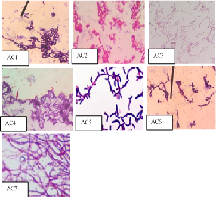Diversity and Potential of Local Actinobacteria from Bedengan Forest for Sustainable Antibiotic Solutions
Abstract
Natural antibiotics may offer a solution to the growing issue of pathogenic bacterial resistance caused by the widespread use of synthetic antibiotics. This study investigates the diversity and potential of Actinobacteria from the rhizosphere of Pinus in the Selorejo Bedengan Forest, Malang City, which has been exposed to synthetic agricultural chemicals for an extended period. Soil samples were collected and analyzed for various environmental factors, including pH, moisture, organic matter, and light intensity. A total of seven Actinobacteria isolates were identified, belonging to the genera Streptomyces and Nocardia. The diversity of these isolates was assessed using the Shannon-Wiener index, yielding a moderate diversity value (H' = 2.74). Antibacterial activity was tested against Escherichia coli and Shigella dysenteriae using the pitting method. The results indicated that isolates AC5 and AC7 exhibited inhibition zones of ≥11 mm and ≥12 mm, respectively, categorizing them as having strong antibacterial activity. These findings highlight the significant potential of local Actinobacteria as candidates for the production of natural antibacterial compounds to combat pathogenic bacteria. This research not only supports the development of more environmentally friendly antibiotic alternatives but also encourages the sustainable use of local microbial resources.
Downloads
References
Alwali, A. Y., & Parkinson, E. I. (2023). Small molecule inducers of actinobacteria natural product biosynthesis. Journal of Industrial Microbiology and Biotechnology, 50(1). https://doi.org/10.1093/jimb/kuad019
Alwi, M., Suharjono, S., Ardiyati, T., & Subandi, S. (2020). Eksplorasi Actinomycetes sebagai kandidat antibakteri patogen yang resisten dari rhizosfer tumbuhan leda (Eucalyptus deglupta Blume.) di Taman Nasional Lore Lindu, Indonesia. Biocelebes, 14(3), 253–267. https://doi.org/10.22487/bioceb.v14i3.15310
Andini, A. S., Suharjono, & Widyarti, S. (2016). Screening of Actinomycetes that produce antibiotics from rhizosphere of medicinal plants in West Lombok, Indonesia as anti-MRSA (Methicilin resistant Staphylococcus aureus). International Journal of ChemTech Research, 9(9), 514–520.
Axenov-Gribanov, D. V., Voytsekhovskaya, I. V., Rebets, Y. V., Tokovenko, B. T., Penzina, T. A., Gornostay, T. G., Adelshin, R. V., Protasov, E. S., Luzhetskyy, A. N., & Timofeyev, M. A. (2016). Actinobacteria possessing antimicrobial and antioxidant activities isolated from the pollen of scots pine (Pinus sylvestris) grown on the Baikal shore. Antonie van Leeuwenhoek, International Journal of General and Molecular Microbiology, 109(10), 1307–1322. https://doi.org/10.1007/s10482-016-0730-5
Barka, E. A., Vatsa, P., Sanchez, L., Gaveau-vaillant, N., Jacquard, C., Klenk, H., Clément, C., Ouhdouch, Y., & Wezel, P. Van. (2016). Taxonomy , physiology, and natural products of Actinobacteria. Microbiology and Molecular Biology Reviews, 80(1), 1–43. https://doi.org/10.1128/MMBR.00019-15.Address
Bhadha, J. H., Capasso, J. M., Khatiwada, R., Swanson, S., & LaBorde, C. (2017). Raising soil organic matter content to improve water holding capacity. Edis, 2017(5), 1–5. https://doi.org/10.32473/edis-ss661-2017
Bhatti, A. A., Haq, S., & Bhat, R. A. (2017). Actinomycetes benefaction role in soil and plant health. Microbial Pathogenesis, 111, 458–467. https://doi.org/10.1016/j.micpath.2017.09.036
Bhowmick, S., Viveros, R. P., Latoscha, A., Commichau, F. M., Wrede, C., Al-Bassam, M. M., & Tschowri, N. (2024). Cell shape and division septa positioning in filamentous Streptomyces require a functional cell wall glycopolymer ligase CglA. MBio, 15(10). https://doi.org/10.1128/mbio.01492-24
Chen, B., & Grinfeld, M. (2024). Decomposing diversity into measures of evenness, similarity, and richness. Ecology and Evolution, 14(2), 1–7. https://doi.org/10.1002/ece3.10952
Cherlinka, V. (2024). Soil moisture: how to measure & monitor its level. Scientist at EOS Data Analytics. https://eos.com/blog/soil-moisture/
de Menezes, A. B., Prendergast-Miller, M. T., Poonpatana, P., Farrell, M., Bissett, A., Macdonald, L. M., Toscas, P., Richardson, A. E., & Thrall, P. H. (2015). C/N ratio drives soil actinobacterial cellobiohydrolase gene diversity. Applied and Environmental Microbiology, 81(9), 3016–3028. https://doi.org/10.1128/AEM.00067-15
Desouky, S. E., Abu-Elghait, M., Fayed, E. A., Selim, S., Igarashi, Y., Abdel-Wahab, B. A., Alsuhaibani, A. M., Nakayama, J., Yousuf, B., & Sonomoto, K. (2022). Secondary metabolites of actinomycetales as potent quorum sensing inhibitors targeting gram-positive pathogens: in vitro and in silico study. metabolites, 12(3). https://doi.org/10.3390/metabo12030246
Donald, L., Pipite, A., Subramani, R., Owen, J., Keyzers, R. A., & Taufa, T. (2022). Streptomyces: Still the biggest producer of new natural secondary metabolites, a current perspective. Microbiology Research, 13(3), 418–465. https://doi.org/10.3390/microbiolres13030031
Dorchenkova, Y. A., Gracheva, T. A., Babich, T. L., Sokolova, D. S., Alexandrova, A. V., Pham, G. T. H., Lysak, L. V., Golovchenko, A. V., & Manucharova, N. A. (2022). Soil Actinomycetes of Vietnam Tropical Forests. Forests, 13(11). https://doi.org/10.3390/f13111863
Golińska, P., & Dahm, H. (2011). Occurrence of Actinomycetes in forest soil. Dendrobiology, 66(January 2011), 3–13.
Henderson, N., & Sutherland, R. (2017). Nocardia and Actinomyces. Medicine, 45, 753–756. https://doi.org/https://doi.org/10.1016/J.MPMED.2017.09.012.
Hoffland, E., Kuyper, T. W., Comans, R. N. J., & Creamer, R. E. (2020). Eco-functionality of organic matter in soils. Plant and Soil, 455(1–2), 1–22. https://doi.org/10.1007/s11104-020-04651-9
Jakimowicz, D., & Van Wezel, G. P. (2012). Cell division and DNA segregation in Streptomyces: How to build a septum in the middle of nowhere? Molecular Microbiology, 85(3), 393–404. https://doi.org/10.1111/j.1365-2958.2012.08107.x
Jakubiec-Krzesniak, K., Rajnisz-Mateusiak, A., Guspiel, A., Ziemska, J., & Solecka, J. (2018). Secondary metabolites of Actinomycetes and their antibacterial, antifungal and antiviral properties. Polish Journal of Microbiology, 67(3), 259–272. https://doi.org/10.21307/pjm-2018-048
Janatiningrum, I., Zahra, A., Fitriyanti, & Anggia, V. (2024). Rhizosphere Actinobacteria isolated from Pometia pinnata and its antimicrobial activity. Biodiversitas, 25(3), 1007–1014. https://doi.org/10.13057/biodiv/d250313
Kaur, M., Sharma, S., Garg, S., & Arora, M. (2018). Study of antibacterial activity of Chenopodium album leaves extract. International Journal of Pharmacognosy and Phytochemical Research, 10(01), 1–4. https://doi.org/10.25258/phyto.v10i01.11923
Kumar, M., Jha, A. K., Hazarika, S., Verma, B. C., Choudhury, B. U., Ramesh, T., Moirangthem, P., Kumar, R., Brajendra, Rajkhowa, D. J., Kumar, A., & Devi, M. H. (2016). Micronutrients (B, Zn, Mo) for Improving Crop Production on Acidic Soils of Northeast India. National Academy Science Letters, 39(2), 85–89. https://doi.org/10.1007/s40009-015-0409-x
Laila, R. R. (2018). Diversitas dan Potensi Bakteri Produksi IAA Rhizosfer Pinus Sp. dari Hutan Universitas Brawijaya Kabupaten Malang [Universitas Brawijaya]. https://repository.ub.ac.id/id/eprint/8854/
Liu, J., Li, F., Gao, C. H., Han, Y., Hao, H., Yi, X. X., & Huang, R. M. (2017). Nocardioides kandeliae sp. Nov., an endophytic actinomycete isolated from leaves of kandelia candel. International Journal of Systematic and Evolutionary Microbiology, 67(10), 3888–3893. https://doi.org/10.1099/ijsem.0.002218
Luo, S., Chen, X. A., Mao, X. M., & Li, Y. Q. (2018). Transposon-based identification of a negative regulator for the antibiotic hyper-production in Streptomyces. Applied Microbiology and Biotechnology, 102(15), 6581–6592. https://doi.org/10.1007/s00253-018-9103-5
Manilal, A., Sabu, K. R., Shewangizaw, M., Aklilu, A., Seid, M., Merdikios, B., & Tsegaye, B. (2020). In vitro antibacterial activity of medicinal plants against biofilm-forming methicillin-resistant Staphylococcus aureus: efficacy of Moringa stenopetala and Rosmarinus officinalis extracts. Heliyon, 6(1), e03303. https://doi.org/10.1016/j.heliyon.2020.e03303
Michael, T., Madigan, K. S. B., Daniel, H. B., Sattley, W. M., & David, A. S. (2017). Brock Biology of Microorganisms (15th Edition) (15th ed.). Pearson.
Mijic, Z., Bray, J. D., Riemer, M. F., Cubrinovski, M., & Rees, S. D. (2021). Test method for minimum and maximum densities of small quantities of soil. Soils and Foundations, 61(2), 533–540. https://doi.org/10.1016/j.sandf.2020.12.003
Nammali, A., Duanguoama, T., Suriyachadkun, C., Tanasupawat, S., & Thawai, C. (2022). Nocardia coffeae sp. nov., an endophytic actinobacteriu isolated from the root of Coffea arabica (L). International Journal of Systematic and Evolutionary Microbiology, 72(1). https://doi.org/https://doi.org/10.1099/ijsem.0.005180.
Neina, D. (2019). The Role of Soil pH in Plant Nutrition and Soil Remediation. Applied and Environmental Soil Science, 2019(3). https://doi.org/10.1155/2019/5794869
Okparasta, A., Susan, D., & Irfannuddin, I. (2020). Characteristics, patterns of pathogens, and antibiotics resistance of bacterial meningitis at Rsup Dr. Mohammad Hoesin Palembang. Jurnal Kedokteran Dan Kesehatan : Publikasi Ilmiah Fakultas Kedokteran Universitas Sriwijaya, 7(3), 61–72. https://doi.org/10.32539/jkk.v7i3.12443
Omayio, D., & Mzungu, E. (2019). Modification of Shannon-Wiener diversity index towards quantitative estimation of environmental wellness and biodiversity levels under a non-comparative scenario. Journal of Environment and Earth Science, 9(9), 46–57. https://doi.org/10.7176/jees/9-9-06
Pisestyani, H., Lukman, D. W., Latif, H., & Sudarwanto, M. (2023). Keberadaan Escherichia coli Extended spectrum β-lactamase resistan antibiotik di peternakan sapi perah Cijeruk, Bogor. Jurnal Veteriner, 23(4), 505–514. https://doi.org/10.19087/jveteriner.2022.23.4.505
Pratiwi, E. R. (2018). Potensi Actinomycetes sebagai Penghasil Antibiotik dari Rhizosfer Pohon Pinus di Hutan Universitas brawijaya (UB Forest), Karangploso Malang [Universitas Brawijaya]. https://repository.ub.ac.id/id/eprint/8835/
Rengel, Z. (2015). Availability of Mn, Zn and Fe in the rhizosphere. Journal of Soil Science and Plant Nutrition, 15(2), 397–409. https://doi.org/10.4067/s0718-95162015005000036
Sharma, M., & Manhas, R. K. (2019). Purification and characterization of actinomycins from Streptomyces strain M7 active against methicillin resistant Staphylococcus aureus and vancomycin resistant Enterococcus. BMC Microbiology, 19(1), 1–14. https://doi.org/10.1186/s12866-019-1405-y
Singh, J. S., & Gupta, V. K. (2018). Soil microbial biomass: A key soil driver in management of ecosystem functioning. Science of the Total Environment, 634, 497–500. https://doi.org/10.1016/j.scitotenv.2018.03.373
Som, N. F., Heine, D., Holmes, N. A., Munnoch, J. T., Chandra, G., Seipke, R. F., Hoskisson, P. A., Wilkinson, B., & Hutchings, M. I. (2017). The conserved actinobacterial two-component system MtrAB coordinates chloramphenicol production with sporulation in Streptomyces venezuelae NRRL B-65442. Frontiers in Microbiology, 8(JUN), 1–11. https://doi.org/10.3389/fmicb.2017.01145
Sriragavi, G., Sangeetha, M., Santhakumar, M., Lokesh, E., Nithyalakshmi, M., Saleel, C. A., & Balagurunathan, R. (2023). Exploring antibacterial properties of bioactive compounds isolated from Streptomyces sp. in bamboo rhizosphere woil. ACS Omega, 8(39), 36333–36343. https://doi.org/10.1021/acsomega.3c04954
Sunarto, Tsaaqifah, H., Purwoko, C., & Pangastuti, A. (2015). The diversity of non-methanogenic bacteria involved in biogas production from tofu-processing wastewater. Biodiversitas, 16(1), 62–68. https://doi.org/10.13057/biodiv/d160108
Świecimska, M., Golińska, P., & Goodfellow, M. (2023). Generation of a high quality library of bioactive filamentous Actinomycetes from extreme biomes using a culture-based bioprospecting strategy. Frontiers in Microbiology, 13(January). https://doi.org/10.3389/fmicb.2022.1054384
Takashima, A., Yagi, S., Ito, H., & Sata, M. (2017). Nocardia identification at the genus level — reply —. Circulation Journal, 81(2), 271. https://doi.org/10.1253/circj.CJ-16-1329
Tistechok, S., Skvortsova, M., Mytsyk, Y., Fedorenko, V., Parnikoza, I., Luzhetskyy, A., & Gromyko, O. (2021). The diversity and antibacterial activity of culturable actinobacteria isolated from the rhizosphere soil of Deschampsia antarctica (Galindez Island, Maritime Antarctic). Polar Biology, 44(9), 1859–1868. https://doi.org/10.1007/s00300-021-02924-2
van der Meij, A., Worsley, S. F., Hutchings, M. I., & van Wezel, G. P. (2017). Chemical ecology of antibiotic production by Actinomycetes. FEMS Microbiology Reviews, 41(3), 392–416. https://doi.org/10.1093/femsre/fux005
Wang, H., Zhao, G., & Ding, X. (2017). Morphology engineering of Streptomyces coelicolor M145 by sub-inhibitory concentrations of antibiotics. Scientific Reports, 7(1), 1–11. https://doi.org/10.1038/s41598-017-13493-y
Zhang, J., Ye, K. P., Zhang, X., Pan, D. D., Sun, Y. Y., & Cao, J. X. (2017). Antibacterial activity and mechanism of action of black pepper essential oil on meat-borne escherichia coli. Frontiers in Microbiology, 7(JAN), 1–10. https://doi.org/10.3389/fmicb.2016.02094
Zhuang, K., Liu, Y., Dai, Y., Xu, J., Li, W., Ming, H., Pradhan, S., Ran, X., Zhang, C., Feng, Y., & Ran, Y. (2021). Nocardia huaxiensis sp. Nov., an actinomycete isolated from human skin. International Journal of Systematic and Evolutionary Microbiology, 71(8), 1–6. https://doi.org/10.1099/ijsem.0.004970

Copyright (c) 2025 Rubiyatna Sakaroni, Isnaniar Rahmatul Azizah

This work is licensed under a Creative Commons Attribution-NonCommercial-ShareAlike 4.0 International License.
Authors who publish with BIOEDUPAT: Pattimura Journal of Biology and Learning agree to the following terms:
- Authors retain copyright and grant the journal right of first publication with the work simultaneously licensed under a Creative Commons Attribution License (CC BY-NC-SA 4.0) that allows others to share the work with an acknowledgment of the work's authorship and initial publication in this journal.
- Authors are able to enter into separate, additional contractual arrangements for the non-exclusive distribution of the journal's published version of the work (e.g., post it to an institutional repository or publish it in a book), with an acknowledgment of its initial publication in this journal.
- Authors are permitted and encouraged to post their work online (e.g., in institutional repositories or on their website) prior to and during the submission process, as it can lead to productive exchanges, as well as earlier and greater citation of published work.








 This work is licensed under a
This work is licensed under a 